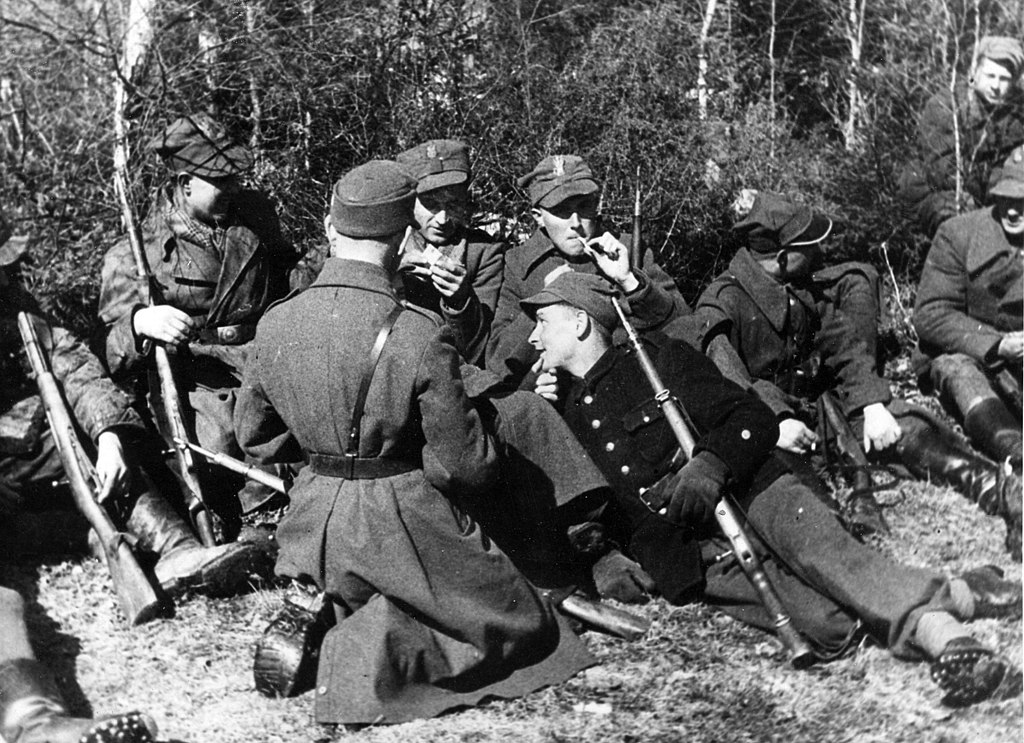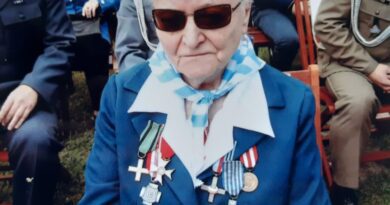Polish Self-defence in Volhynia. They managed to save thousands of civilians

Some Poles living in Volhynia decided to resist the attacks, with guns, knives, scythes, axes, and what else they could grab. They managed to save thousands of their compatriots.
Poles, who made up a dozen or so percent of the population of Volhynia, being threatened by the massacres committed by the Ukrainian nationalists from UPA and collaborating Ukrainian local community, began to form self-defence outposts in villages and small towns. They could not count on effective help of the Home Army (Armia Krajowa or AK). In April 1943, Colonel Kazimierz Bąbiński, District Commander of AK Volhynia (AK Wołyń) ordered his subordinates to take over the initiative of forming self-defence outposts. However, only a part of these outposts was in the hands of AK soldiers.
AK partisan units began to be formed only after the culmination of mass murders in July. As recalled by Ewa and Władysław Siemaszko, in 1943, the support provided by the AK Headquarters to Poles in Volhynia consisted of delegating several dozen or so officers who took command over partisan units. However, no weapons or ammunition was sent, probably due to their general shortage.
Help even from the devil himself
Unfortunately, the concept of forming civic guard units in municipalities was abandoned. The proposal of their formation was submitted to the Germans by Adam Ronikier, President of the Main Welfare Council (RGO). The units were supposed to protect citizen from bandits. The activity of robbery gangs was a serious problem during German occupation, but the formation of the first civic guard units was planned in Volhynia, in response to the aggravating slaughters of Poles.
The Government Delegation for Poland – being a representation of the Polish government-in-exile – rejected the idea of forming the civic guard. The reason for its refusal was the principle that Poles would not make any political arrangements with the Germans. The establishment of the civic guard would be badly perceived by our allies and the Soviet Union would definitely use the activity of such guard for its propaganda.
However, the Poles living in Volhynia were fighting for their lives so now and then they had to accept help from the Germans in the form of supplies of weapons and ammunition. They sought help from Soviet partisans and there were times when they collaborated with them against UPA. In view of the recurrent murders and massacres committed by the Ukrainian Insurgent Army, it has become necessary to form local alliances with two enemies in order to avoid death at the hands of the third one – the Ukrainian nationalists. To this day it has been a reason for some Ukrainians to accuse Poles of collaboration with the Germans and Soviets targeted at their fight for the independent Ukraine.
The Poles in Volhynia were short of firearms. On 11 July 1943, an UPA unit appeared in a small town of Kisielin. There was no self-defence outpost in that place. When Poles started to walk out of the church after the mass, they saw armed UPA militants. The massacre began. UPA killed 86 people (including three children at the age of less than 10 and nine adolescents). Some Poles managed to run away and hide on the first floor of the rectory. The Ukrainians started chopping the door but they retreated when one of the barricaded men also took an axe in desperation and their blades hit against one another. Hand grenades were thrown back at the invaders. The defenders also attacked them with bricks. Discouraged Ukrainians retreated after dusk.
„The maximum number of self-defence outposts existing simultaneously, both autonomous and operating as part of larger centres (bases), was recorded in July 1943 and amounted to 128. That number, when compared to almost 3,400 villages and towns inhabited by Poles and the fact that 50–60 thousands were murdered shows how limited was the Polish self-defence. If the self-defence in Volhynia was more developed and able to counteract the assaults of OUN-UPA, but also conduct offensive fight and take retaliatory measures there would not be so many victims in Volhynia”. This is the opinion of Ewa and Władysław Siemaszko contained in their comprehensive publication entitled „Ludobójstwo dokonane przez nacjonalistów ukraińskich na ludności polskiej Volhynia 1939–1945”. [“Genocide of the Polish population in Volhynia committed by the Ukrainian nationalists in years 1939–1945″]
Village becomes a stronghold
Przebraże village, located in the Łucki county and being its largest centre, has become the symbol of self-defence of Poles in Volhynia. In February 1943, a self-defence unit was established in Przebraże and its command was taken by Henryk Cybulski, a forester, participant of the September Campaign of 1939, non-commissioned reserve officer, and an AK soldier.
„Poles have no illusions anymore. They know that what happens here are not excesses of gangs or local riots or even long standing hatreds […]. Village outposts, lookouts, defence and alarming groups are being established in larger villages and settlements. People arm themselves with pitchforks, old sabres, bayonets, and less often with guns and double-barrelled guns” – wrote Henryk Cybulski in his book “Czerwone noce” [„Red nights”].
Participants of the self-defence of Przebraże started to pull out weapons hidden and abandoned in September 1939 by Polish soldiers, and in June 1941 by Red Army soldiers. They managed to convince the Germans stationed in the nearby town of Kiwerce that they would give them some guns and ammunition. Weapons and ammunition were also bought from the Hungarian soldiers guarding the Kiwerce railway line. In addition, weapons were passed by the inspectorate of the Home Army in Łuck. Self-defence was organized on the model of military forces. Four companies counting 150-200 people each were created. They were sworn in as members of the Home Army.
The news about establishment of the main self-defence outpost spread quickly both in the neighbouring and in more distant villages. Their defenceless population threatened to be murdered by UPA, started to arrive to Przebraże.
Together with the neighbouring colonies, Przebraże has become a stronghold with entanglement, fire trenches, and fortifications made of earth and pine logs. Approximately 10–12 thousand people sheltered there.
„We created something like a little state with our own army, administration and judiciary […]. One should admit that on those days, the farmers from Przebraże showed responsible citizenship. The tragic events triggered a sense of solidarity, generosity, and even sacrifice in them. During assignment of lodging, collection of voluntary or compulsory donations for the survivors, no one protested, there was no shouting or refusals. They shared with the refugees whatever they had: flour, potatoes, milk, and clothing “- wrote Henryk Cybulski.
Poles from Huta Stepańska
Among those who arrived to Przebraże, there were people from a self-defence outpost in Huta Stepańska defeated after fighting that took place on 16–18 July 1943. The population of that settlement counted ca. 800 inhabitants, and gave shelter to 3–5 thousand Poles from surrounding areas.
The defenders of Huta Stepańska had only several dozens of guns. The rest of their weapons were poles with attached bayonets and scythe blades. The defence of Huta Stepańska was commanded by Lieutenant Władysław Kochański aka „Bomba”, a special forces paratrooper [belonging to a group nicknamed cichociemni, meaning “Silent Unseen”]. UPA units accompanied by the Ukrainians living nearby broke into the village several times. The Poles defended themselves, some of them were even fighting unarmed. They were highly outnumbered by the Ukrainians and short of ammunition. The only hope was to try to break out of the encirclement.
The members of self-defence pushed the enemy using their highest efforts, paving the way for a column of carts, which transported the wounded and children. Luckily a heavy fog hid the procession. Although the carts arrived at a safe place, as a result of the attack of UPA, about 600 Poles were killed. Mainly those who tried to save themselves on their own. Kochański, who was seriously injured during the fight in Huta Stepańska, soon formed a partisan unit stationed in the village of Huta Stara. It counted 500 people. Among them, there were residents of the village, which has become the self-defence outpost protecting approximately 10,000 Poles.
On 16 November 1943, Lieutenant Kochański commanded a successful defence of Huta Stara. As Grzegorz Motyka writes in his book “From Volhynia massacre to the »Vistula« Operation”, it was one of the greatest successes of Poles in their fights with UPA: as many as 54 Ukrainians were killed and 40 of them wounded. Taking revenge for the defeat, the fleeing UPA units killed 15 Poles in Bielczakowska Kolonia.
During the night, from 4 to 5 July 1943, UPA units started their march towards Przebraże, burning one Polish settlement after another on their way and killing all their residents who were still alive. That was the fate of, among others, Dermanka settlement. „The day before, a young Ukrainian from Horodyszcze arrived on horseback to reassure people that no one was in danger due to the imminent march of “troops”. Slaughter was conducted with a variety of tools, such as pitchforks, saws, knives and pins, which later were found abandoned next to dead bodies “- wrote Ewa and Władyslaw Siemaszko. In Dermanka, more than 60 Poles were murdered. In Józefin colony, several people were nailed to the wall of the forge, which was then set on fire. That night, UPA murdered about 500 Poles in and around Przebraże.
Defence and counterattacks
Przebraże was attacked at dawn. “When the first shock passed, it became clear for everybody that there was no other option of saving than a struggle inside the camp. Young men who had no weapon, pulled out knives, scythes, everything that might have been a weapon, and decided to fight to the end “- wrote Cybulski.
As a result of successful defence of Przebraże and slaughters carried out by UPA in the neighbouring settlements, another wave of refugees arrived at that self-defence centre. Przebraże has also become a shelter for Jews who were hiding in forests amid marshes. These were the families of the Blisztajns from Trościaniec and the Kaces. They would not survive in their shelters but for the help provided by Alojzy Ludwikowski from Przebraże, who assisted in the construction of dugouts and supplied food.
The defenders of Przebraże decided to conduct a counterattack. On 12 July, they destroyed the base of UPA in Trościaniec, where its non-commissioned officers’ training school was located. After that operation people in Przebraże believed in their own strength and the ability to survive.
Another assault on Przebraże took place on 30 August 1943. Several thousands of UPA militants and Ukrainians peasants armed with axes (they were called „siekiernicy” meaning “axe-men”) gathered around the village. Carts with which they intended to transport the loot were already waiting nearby. „Stories were told of riches and all kinds of goods, that the Poles have amassed in Przebraże. Everyone was promised that the attack on Przebraże would be a perfect occasion for a real spree and valuable loot. So, apart from the units of virulent nationalists, various gangs of regular crooks and criminals also joined the forces marching towards Przebraże” – recalled long afterwards Mirosław Łoziński, the then 17-years-old member of the self-defence, in the book of Marek A. Koprowski „Wołyń. Epopeja polskich losów 1939–1945” [„Volhynia. The great epic of Polish fate in 1939–1945”].
The defenders could set ca. 600–800 people against the enemy. Ukrainian commanders encouraged the attackers, shouting: “Rezuny [“murderers”] [, sikirnyki [“axe-men”]forward! Poles do not have bullets. ” However, the defenders of Przebraże mounted successful resistance. They also called for help a Soviet partisan unit, which attacked the UPA units from behind together with a part of the Polish forces. The attack of UPA on Przebraże, whose aim was to eliminate Polish self-defence and murder Poles, failed.
The trip to Ołyka
The last action of saving the Polish population by the self-defence of Przebraże was a trip to Ołyka. Despite the presence of the German garrison, Poles were kept being murdered there. Władyslaw and Ewa Siemaszko wrote in their book about killing 14 Poles, including seven children, gathered on the Christmas Eve, 24 December 1943 in the house of the family Borowski, located on the outskirts of the town and a family of five in another house. “Father had cleaved head and his hands cut off, his wife was massacred, and two sons (seven and nine years old) had their fingers cut off, whereas a six-month-old daughter was strangled with a string”.
When the German soldiers left Ołyka at the beginning of January 1944, fleeing from the approaching Red Army, Poles found shelter in the castle owned by the Radziwill family. It was surrounded by a unit of UPA. The Poles had a dozen or so guns to fight back, but a small quantity of ammunition and food. The besieged managed to notify the self-defence outpost in Przebraże. A 300-person detachment equipped with 250 sledges for evacuating people arrived on time to Ołyka and dispersed the UPA militants. Henryk Cybulski recalled that his troops found a record player in one of the abandoned houses. “They brought it to the yard and played the first record chosen at random. Believe it or not, but it was Dąbrowski’s Mazurka [Polish national anthem]”.
Unfortunately, few outposts and centres of self-defence repelled the attacks of UPA – 14 centres (bases) and seven autonomous outposts altogether. Among them there was Przebraże. Most of these places could be defended thanks to AK troops which began to be formed in the summer of 1943. As Grzegorz Motyka writes in the book “From the Volhynian massacre to the “Vistula” Operation,” there were nine of such units and they counted about 1 thousand soldiers. UPA troops outnumbered them more than ten to one.
Contrary to what is claimed by many Ukrainian historians, there was no Polish-Ukrainian war in Volhynia in 1943 . What happened there was a slaughter, which was in fact genocide of Poles living in Volhynia, committed by the Ukrainian Insurgent Army and a part of the Ukrainian population supporting UPA. The Poles tried to defend themselves and many thousands of people owe their lives to self-defence outposts, and a few units of the Home Army. Their forces, however, were so weak that it could not prevent the murder of 50-60 thousand Poles.
This article was published in “Do Rzeczy” magazine.



